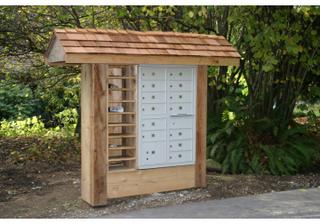Recently we decided to install a secure mailbox solution for our neighborhood. I thought I'd write a few words about that experience since it's not as straightforward as it may at first seem.
The first choice you need to make is whether to stick with individual secure mailboxes or whether to move to a Cluster Box Unit (or CBU). We decided to go with the CBU for several reasons:-
- More cost effective overall, individual boxes run $250-$300, we could install a CBU for ~$200 per mailbox.
- More secure: nobody is going to drag a 100lb mailbox off its concrete anchors~
- Provides secure outgoing mail which the individual boxes do not.
- Neater overall when built into a new compact mailstand.
- More efficient for the mailman, they can deliver to all mailboxes with just one unlock operation.
We puchased our CBU online from American Mailboxes and it arrived as promised. During installation we found one small problem in that the left hinge rod wasn't quite sunk low enough in the hole and it caught on the upper door jamb. This was easy to fix, and apart from that the unit is extremely well built.
Auth-Florence is the manufacturer of all the various CBUs you might want. They have various configurations from an 8 box unit to a 16 box unit. The 13 box unit has larger slots in it so you might want to consider that even if you have only 8 addresses as we did.
After pouring a concrete base with anchor bolts in it the box was mounted in place. A new cedar structure was then built around it to house the newspaper slots, and a shingle roof placed over it. The finished unit will blend nicely into the surroundings, and I'll post a picture when it's all done. I found the mailbox to be somewhat less rigid than I would have liked (there is some give in the mounting column), adding a rigid cedar structure around it improved this somewhat.
So now for the tricky part. Before you install a CBU you need to check with your local post office and get their approval. Ask for the 'delivery manager'. You then order it and install it. Now, label each slot with the old mailbox numbers, but you must do this in Carrier Route Order which is typically the order the mailboxes were on the mail stand before but in right-to-left order. If you can meet your mailman, work with him directly to label the slots the way he wants them before you hand out the keys. They typically write the house numbers on the metal shelves inside using a black marker. You do not label the outside of the mailboxes in any way other than the numbers 1-13 (or whatever) that they came with. Next you need to call back to the 'delivery manager' and ask them to come out and fit their keys to the mailboxes. After they do this you will not be able to gain entry to anything but the mailbox you own so make sure you are done labelling and installing the CBU before you call. After they've fitted their locks you can take down your old mailboxes and from now on all your mail will be secure.
With identity theft on the rise the installation of a secure mailbox like this seems like an obvious thing to do and I highly recommend it to anyone considering it.
 Finally the mailboxes are finished and here's what they look like. As you can see, I tried to blend the gray Cluster Box Unit "CBU" in with its rustic surroundings by wrapping it in cedar and adding a cedar shake roof over it. Down the left the individual newspaper slots are sheltered from rain by the overhanging roof.
Finally the mailboxes are finished and here's what they look like. As you can see, I tried to blend the gray Cluster Box Unit "CBU" in with its rustic surroundings by wrapping it in cedar and adding a cedar shake roof over it. Down the left the individual newspaper slots are sheltered from rain by the overhanging roof.
